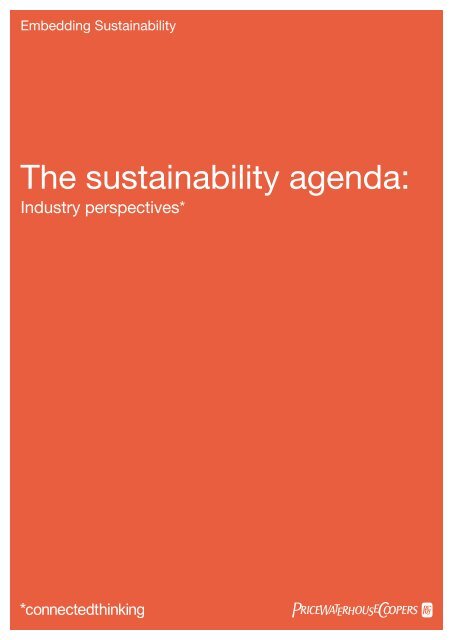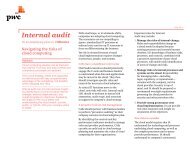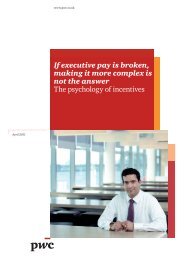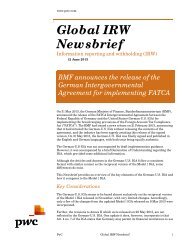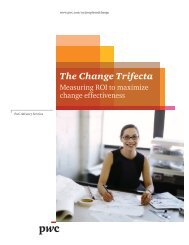The sustainability agenda: - PwC
The sustainability agenda: - PwC
The sustainability agenda: - PwC
You also want an ePaper? Increase the reach of your titles
YUMPU automatically turns print PDFs into web optimized ePapers that Google loves.
Embedding Sustainability<strong>The</strong> <strong>sustainability</strong> <strong>agenda</strong>:Industry perspectives*
Contents01 <strong>The</strong> Sustainability Agenda06 Industry Perspectives: Energy08 Industry Perspectives: Transportation andLogistics10 Industry Perspectives: Retail andConsumer12 Industry Perspectives: Technology14 Industry Perspectives: Banking andCapital Markets17 How PricewaterhouseCoopers can help18 Contacts
PricewaterhouseCoopers 1‘This <strong>agenda</strong> of <strong>sustainability</strong> and corporate responsibility is not only central to businessstrategy but will increasingly become a critical driver of business growth....I believe thathow well and how quickly businesses respond to this <strong>agenda</strong> will determine whichcompanies succeed and which will fail.’Patrick Cescau, CEO of Unilever<strong>The</strong> Sustainability AgendaMany in business have long viewed<strong>sustainability</strong> — efforts to avert climatechange, for example, or to improveeducation in underserved neighbourhoods— a matter of corporate philanthropy, withno relevance to their corporations’ corestrategies. <strong>The</strong> costs of such activitieswere seen as detracting from profitabilityand accounted for on a public relationsline under marketing; their scope waslimited but they were promoted withconsiderable fanfare.However, this perspective has changed.Corporations have come to understandthat their abilities to prosper hinge upontheir responses to the challenges of acarbon-constrained world and an array ofother issues on the <strong>sustainability</strong> <strong>agenda</strong>.Instead of seeing efforts to increase fuelefficiency in operations and to ensure thatsuppliers in emerging markets providesafe working conditions for theiremployees as costs, corporate leadersnow see these initiatives as investments inopportunities to operate more efficientlyand secure a dependable supply chain.<strong>The</strong> Economist Intelligence Unit (EIU)found in a survey that 57% of topexecutives believe that the benefits ofefforts to achieve <strong>sustainability</strong> outweighthe costsFindings also confirm <strong>sustainability</strong>’s riseon the corporate <strong>agenda</strong> and its link tocompetitive advantage. Fifty-three percentof executives surveyed by the EIU saythey have coherent <strong>sustainability</strong> policies.<strong>The</strong> same percentage reports thatresponsibility for <strong>sustainability</strong> in theirorganisations has been placed at the CEOor board level.Yet, businesses know there is much moreto be done. For example, only 6% of thecompanies surveyed by the EIU ratethemselves as outstanding in reducingemissions, waste and pollution. And only athird of the executives surveyed worldwidesay their <strong>sustainability</strong> policies extendedto their supply chains.While the global challenges related to<strong>sustainability</strong> are manifest, defining howbusinesses can meet the challenges canbe daunting. Sustainability canencompass a broad range of issues thataffect business — from pollution andclimate change to education, poverty,health and human rights. It involves aconnected world with a broad range ofstakeholders—from employees andcommunities to governments and NGOs.And it includes operations in parts of theworld with differing jurisdictions,regulations and standards of practice. Notsurprisingly, businesses often wonderwhere to begin.What is the <strong>sustainability</strong><strong>agenda</strong>?<strong>The</strong> <strong>sustainability</strong> <strong>agenda</strong> begins withmaking a commitment to incorporatingsocial, environmental, economic andethical factors into a company’sstrategic decision-making. It extends toevaluating how these factors affect thebusiness — including all of itsstakeholders — and what risks andopportunities these factors present.Finally, the <strong>sustainability</strong> <strong>agenda</strong> asksbusinesses to adopt measures tomitigate risks and take advantage ofopportunities
2 <strong>The</strong> <strong>sustainability</strong> <strong>agenda</strong>: Industry perspectives*‘<strong>The</strong> most frequently cited benefits that firms expect from<strong>sustainability</strong> policies relate to improved business outcomes: theability to attract and retain customers (37%), improved shareholdervalue (34%) and increased profits (31%).’Economist Intelligence Unit Survey, Doing Good: Business and the Sustainability Challenge, 2008<strong>The</strong> <strong>sustainability</strong> mindsetMost forward-looking businessesunderstand that the traditional trade-offbetween <strong>sustainability</strong> and profitability isan outmoded perspective. <strong>The</strong>y know thatoperating sustainably is a mindset with afocus on the creation of long-termshareholder value. That means adhering tothe fundamental tenets of goodentrepreneurship — identifying thechanging needs and demands of society,and responding with successful businessmodels. Business leaders who operatesustainably recognise that social,environmental, economic and ethicalfactors affect their core businessstrategies. <strong>The</strong>se leaders evaluate thespectrum of <strong>sustainability</strong> issues andrespond by mitigating risks and leveragingopportunities.<strong>The</strong>y also understand that the<strong>sustainability</strong> <strong>agenda</strong> requires workingcollaboratively with all stakeholders —from suppliers and customers toemployees, shareholders andgovernments. InPricewaterhouseCoopers’s 11th AnnualGlobal CEO Survey, conducted in 2007,82% percent of CEOs said thatgovernments should take more of aleadership role in addressing climatechange, and 73% said that businessesneeded to collaborate with industry peersand business partners to mitigate climatechange. Indeed, in a connected world, acompany’s success rides on the practicesof its network of suppliers, distributors,service providers and retailers — in termsnot only of efficiency, but also ofreputation. One weak link could be costlyfor the entire network. And the<strong>sustainability</strong> <strong>agenda</strong> shapes bothefficiency and reputation.Assessing risks<strong>The</strong>re are at least four broad categories of<strong>sustainability</strong>-related risks:• Scarcity of raw materials – rawmaterials, including everything fromfossil fuels and minerals to food andwater, are finite and scarcity is now afact of life on the planet. Look no furtherthan recent rises in the prices ofcommodities ranging from oil to wheat,both of which hit all-time highs in 2008,for evidence that demand for naturalresources is creating scarcity. It hasbeen estimated that if the worldpopulation consumed at the currentlevel of member-countries of theOrganisation for Economic Co-operationand Development (OECD), the richnation’s club, at least two more planetswould be required to support them.Without such an escape route, theincreasing scarcity of raw materialspushes up costs that, in turn, exertpressure on margins.• Regulation – new regulations areplacing a cost on business necessitiesthat have been free or inexpensive, suchas water, air and waste disposal. <strong>The</strong>accelerating trend of governmentsplacing a price on carbon dioxideemissions is the most prominentexample. This trend may have an impacton a company’s suppliers, a company’sown operations as well as on theproducts it sells.• Reputation – a company’s reputationturns on its compliance with a broadrange of social, product quality andother expectations, as well as withexplicit laws and regulations. A businessmay be operating within legalboundaries but can be punished bystakeholders whose values may beaffronted if, for example, the wages acompany pays its production workersdo not constitute living wages or ifsafety conditions are deemedinadequate. Or a local employer couldarouse resentment and endure sharpcriticism if it moves operations, andjobs, offshore. Companies can alsoseriously impair their reputations if theyare linked to bribery or corruption. Aflawed reputation for environmental,social or ethical factors can jeopardise acompany’s image amongstconsumers—as well as in the pipeline oftop talent.• Climate change/Physical risks –hurricanes, flooding, droughts and otherenvironmental events made moreextreme by warming oceans andclimatic change can destroymanufacturing plants or transportationinfrastructure, disrupting supply chainsas well as production, and escalateinsurance costs.
PricewaterhouseCoopers 3CEOs clamour for government leadership in addressing climate change, but they alsorecognise the value of business collaborationGovernments should take more of aleadership role in determining mitigationstrategies for climate change2639 43Developed countries should accept moreresponsibility and costs than developingeconomies for mitigating climate change5836 39Businesses need to collaborate moreeffectively with industry peers and businesspartners in mitigating climate change3643 30My organisation is investing significantresources to address the risks andopportunities of climate change162126 11I am more active in my private lifethan I am as a CEO in addressingclimate change172120 11Disagree strongly Disagree AgreeAgree stronglyQ: To what extent do you agree or disagree with each of the following? (Base: All respondents 1,150)Source: PricewaterhouseCoopers 11th Annual Global CEO Survey 2008Large companies are more likely to agree or agree strongly. <strong>The</strong>y are investing significantresources to address the risk and opportunities of climate change while CEOs indeveloping nations put greater emphasis on government leadershipRegionRevenue sizeCEELatinAmericaAsiaPacificWesternEuropeNorthAmericaOver $10billion$1 billion to$10 billion$100 millionto $999 millionLess than$100 millionGovernments should take more of aleadership role in determining mitigationstrategies for climate change87%87%90%76%64%80%81%78%87%Developed countries should accept moreresponsibility and costs than developingeconomies for mitigating climate change76%88%75%71%61%65%73%71%78%Businesses need to collaborate moreeffectively with industry peers and businesspartners in mitigating climate change86%90%82%70%69%74%78%68%77%My organisation is investing significantresources to address the risks andopportunities of climate change27%40%42%39%28%56%47%28%31%I am more active in my private lifethan I am as a CEO in addressingclimate change29%38%38%28%23%18%27%34%38%Base86136277454130103281410241Q: To what extent do you agree or disagree with each of the following? (Base: All respondents 1,150)Source: PricewaterhouseCoopers 11th Annual Global CEO Survey 2008
4 <strong>The</strong> <strong>sustainability</strong> <strong>agenda</strong>: Industry perspectives*‘Sustainability is the single biggest business opportunity of the 21stcentury, and will be the next source of competitive advantage.’H. Lee Scott, President and CEO of Wal-MartIdentifying opportunitiesOperating sustainably does not only entailcontaining risks. For leading businesses,assessing the risks that all stakeholdersface can yield rich opportunities. <strong>The</strong>growing number of consumers seekinghealthy and sustainable lifestylesconstitutes a potentially vast market fornew products and services. Consumers’environmental, ethical and socialconcerns, for example, mean that theirdefinitions of quality extend to products’lives before and after their use. <strong>The</strong>y mayplace a higher value on digital camerasbuilt in plants where workers are protectedfrom toxic components, whose parts arereusable and whose manufacturers takeresponsibility for the recycling of thoseparts. Wherever environmental, social orethical issues can be addressedbusinesses have an opportunity toinnovate, differentiate, create value andattract more customers. <strong>The</strong>y are alsoopportunities to attract and motivateemployees.Although businesses now understand thatpursuing <strong>sustainability</strong> is a long-terminvestment, they constantly face thechallenge of alleviating shareholderconcerns about short-term results thatmay disappoint because of the company’slonger-term objectives. <strong>The</strong>ir continuingchallenge is to clearly communicate thatoperating sustainably is an inescapableimperative for businesses that aspire toprosper on the only planet currentlyavailable to them.Sustainability issues pose a unique set ofchallenges and afford a distinct set ofopportunities to every sector. <strong>The</strong> globalreach and complexity of supply chains,raw materials required for production, thenature of products and the specialcharacteristics of a company’s workforceall determine which risks play the mostsignificant roles in any given sector, andwhich opportunities exist. We havehighlighted these unique combinations forfive key sectors: energy, transportationand logistics, retail and consumer,technology, and banking and capitalmarkets. In each, we’ve also included oneor two brief case studies, describing howleading companies, with the help ofPricewaterhouseCoopers, havesuccessfully adopted the <strong>sustainability</strong><strong>agenda</strong>.
PricewaterhouseCoopers 5
6 <strong>The</strong> <strong>sustainability</strong> <strong>agenda</strong>: Industry perspectives*Industry Perspectives: Energy<strong>The</strong> global energy sector is dominated bythe fossil fuels whose consumption isinextricably linked with carbon dioxideemissions and global climate change: oil,gas and coal produce over 80% of theworld’s energy according to theInternational Energy Agency. As such,energy companies stand on the front linesof the challenges presented by relentlesslyrising energy costs and climate change.RisksAny company dependent on fossil fuelextraction, processing or delivery clearlyfaces <strong>sustainability</strong> risks. While priceincreases create short-term opportunities,companies must face the challenges of acarbon-constrained world and finiteresources to ensure their long-termviability. Indeed, many governmentsexpect energy producers to account forthe majority of the reductions sought incarbon emissions. For energy companies,the challenge entails both improvingdemand and supply side efficiency inorder to reduce emissions.Energy companies also face the risk of thegrowing scarcity of fossil fuels. Escalatingcosts arise from the need to exploreremote regions and develop smaller scalereserves under adverse and hazardousconditions. Fossil fuels must be extractedfrom ever more inaccessible geologicformations and deeper waters, and inmore environmentally and politicallysensitive areas. <strong>The</strong> exigencies ofmounting scarcity exacerbate energycompanies’ longstanding challenge ofprotecting the health and safety of theiremployees working in extremeenvironments.In view of these trends, energy companiesmust respond to the growing demand forclean, renewable energy. Yet, inconsidering nuclear energy amongst itsoptions, companies face the multiplechallenges of public concerns about thedangers of nuclear energy, widespreadopposition to large infrastructure projectsof any kind, formidable investment anddecommissioning costs, and nuclearwaste disposal.Opportunities<strong>The</strong> sector has a number of opportunitieson both the supply and demand sides ofenergy production and consumption.Many companies have longstanding,though modest, initiatives in thedevelopment of energy alternatives fromwind and solar, to fuel cells and tidal.Biofuel additives to transportation fuelsare being mandated in the EU and manyLatin America countries, with the hope ofreducing reliance on gasoline and diesel,adapting the vehicle and fuelling stationinfrastructure, and seeding new industriesin biofuel production and processing. Allof these areas will require technologies toadvance and capital is indeed flowingtowards ‘clean tech’: venture capitalinvestments in the field rose nearlyfive-fold from 2005 to 2007, according tosome estimates. In addition, the payoff forsignificant advances in the area of carboncapture and storage could be substantial.On the demand side, energy companiescan invest in the development ofinnovative programmes to encourage andenable businesses, governments andindividuals to reduce their energyconsumption. Under one such newbusiness model, companies guaranteeenergy supplies at a fixed price tocustomers, undertake a range of efficiencymeasures for their operations and thensplit the resulting savings with them.
PricewaterhouseCoopers 7‘If you want to continue to succeed as an energy company in thecoming decades, you need to understand and meet people’sexpectations for environmental and social performance, as well asdelivering solid technical and financial performance. That meansputting solid business principles, including sustainabledevelopment, at the heart of how you do your business.’Jeroen Van der Veer, CEO of ShellCase studyA major European electric utility that planned to diversify its energy production and builda renewable energy division conducted extensive due diligence when it considered theacquisition of a small waste-to-energy biogas company. <strong>The</strong> due diligence included ananalysis of the current and potential market for biogas, as well as of the target company’senvironmental and operational status. <strong>The</strong> market analysis took into account anticipatedlegislation, market conditions and consumer preferences. In analysing the target, theutility reviewed <strong>sustainability</strong> factors and how they related to performance and financialmeasures. Following the due diligence, the utility acquired the company, its first majorinvestment in renewable production. <strong>The</strong> biogas company will form the cornerstone ofthe utility’s new renewable division, a long-term strategic initiative. <strong>The</strong> utility expects thedivision to be a major growth area, although it is not expected to be a significantcontributor to revenues for many years. <strong>The</strong> acquisition, however, received wide andfavourable publicity.Questions to consider:• Can you be sure that your overseasoperations do not become a liabilityin terms of your reputation?• What investments are you makingin non-fossil fuel energy sources?What is the timeframe forcommercialization and how realisticare the prospects?• Will new energy sources ortechnologies change how energyproviders, distributors andconsumers work with one another?Are you preparing for that future?Case studyIn response to a number of environmental and safety incidents and the need for betterperformance and management information, a major oil company sought to improve howit monitored risks across all facets of its business—upstream and downstream —including pipelines, terminals, upstream production, and refining and marketing. <strong>The</strong>company inventoried and analysed its history of environmental and safety incidentsacross its operations. From that inventory it developed a system of identifying risks andinstituting controls to limit those risks. <strong>The</strong> risk controls established maximum andminimum tolerable performance measures, both leading and lagging, to help themanagement team understand where issues exist and where risks could potentiallymanifest throughout the organisation.
8 <strong>The</strong> <strong>sustainability</strong> <strong>agenda</strong>: Industry perspectives*Industry Perspectives: Transportation andLogisticsAside from the energy sector, thetransportation and logistics sector isarguably the most directly affected by theaccumulating regulatory demands to curbgreenhouse gas emissions and the risingcosts of fossil fuels. <strong>The</strong> transportationsector accounts for almost 60% of energyconsumption in OECD countries and over40% in non-OECD countries, according tothe US Energy Information Administration.RisksTo a large degree, the transportation andlogistics industry faces the same risks onclimate change and energy prices as theenergy sector. Hedging strategies canpartially mitigate the risks of energy costsbut ultimately some risks will need to beborne.However, the sector also confronts thechallenge of safely transporting dangerouschemicals and toxic substances over longdistances including through denselypopulated neighbourhoods andenvironmentally sensitive areas. Inaddition, the industry has to address thetask of minimising its other substantialenvironmental impacts: noise and airpollution.OpportunitiesReverse logistics represents a major areaof opportunity for transportation andlogistics companies. Reusing or properlydisposing of not only their own equipmentand vehicles, but also the products ofcustomers, is a rapidly growing businessto companies in this sector.Transportation and logistics businessesthat take a leading role in deployingenergy saving and alternative energydriven vehicles, aircraft and other modesof transportation also stand to gain anadvantage over competitors in costsavings, public relations and regulatorycompliance. UPS recently announcedorders to expand the use of hybrid-electricand compressed natural gas trucks in itsdelivery fleet. Players in the sector mayfurther gain an edge by redesigningdistribution patterns to reduce distancestravelled and by innovating systems foroperating vehicles more efficiently. FedExuses route planning software to map outmaximally efficient routes. Othercompanies have realised significantsavings simply by training drivers on moreenergy efficient driving habits.<strong>The</strong>re are also opportunities for productinnovation. One country’s postal service,for example, offers carbon neutral deliveryoptions such that it charges a smallpremium for parcel delivery in exchangefor the promise that it will buy carboncredits in energy reduction effortselsewhere that offset the carbon used inthe delivery of the posted item.
PricewaterhouseCoopers 9‘Two-thirds (66%) of transportation and logistics CEOs are worriedabout the potential threat to business growth as a result ofincreased carbon emissions regulation.’PricewaterhouseCoopers 11th Annual Global CEO SurveyCase studyIn response to stakeholder requests, a major rail transportation and aircraft companyundertook a variety of corporate responsibility initiatives. Its goals in doing so includedimproving business processes, improving employee health and safety, reducing thelife-cycle cost of its products, managing energy consumption, and improving stakeholderengagement. It instituted a global corporate responsibility programme, committed itselfto achieving and maintaining a listing on the Dow Jones World and North AmericaSustainability Indices, and became a member of the United Nations Global Compact. Itsmajor achievements included the adoption of a code of ethics for suppliers. <strong>The</strong> overallinitiative has enabled the company to publicise its corporate responsibility commitments,market the environmental advantages of its transit solutions to municipal and privatecustomers, and improve stakeholder engagement. On the basis of that success, thecompany now plans to undertake <strong>sustainability</strong> reporting, an analysis of the carbonimpact of rail transportation versus other modes, and the formulation of a carbon andenergy management strategy.Questions to consider:• How are you managing the risksthat stem from volatile energyprices?• What do you know about the futurepreferences of your strategicclients?• Are you investing in more energyefficient vehicles?• Do your operations have otherimpacts, such as noise or emissionsor the transport of hazardoussubstances, that could become aconcern for stakeholders?Case studyA major river transportation company sought to promote the inland river transportationinfrastructure in Europe and to build government support for canal projects. It conductedmarket surveys to determine the expectations of customers regarding <strong>sustainability</strong>, andcompetitive analyses of the impact of canal transport versus road and rail transport froma <strong>sustainability</strong> perspective. It also conducted a comprehensive assessment of thecarbon-emissions benefits of a new transnational canal it was building. <strong>The</strong> companydrew on these findings to make the case for inland river transportation’s contributions to<strong>sustainability</strong> before public authorities.
10 <strong>The</strong> <strong>sustainability</strong> <strong>agenda</strong>: Industry perspectives*Industry Perspectives: Retail and ConsumerThat <strong>sustainability</strong> has become a part ofthe global zeitgeist became abundantlyclear when An Inconvenient Truth, formerUS Vice President Al Gore’s documentaryon global climate change, won anAcademy Award in 2007, and when Goreand the United Nations IntergovernmentalPanel on Climate Change followed up witha Nobel Peace Prize later that year.Awareness of <strong>sustainability</strong> has neverbeen higher, and consumers around theworld are factoring <strong>sustainability</strong> into theirpurchasing decisions. This hasramifications for all consumer-facingbusinesses.RisksCompanies that do not respond toconsumers’ growing demand for LOHAS(lifestyle of health and <strong>sustainability</strong>)products risk losing a significant market.Consumers’ interest in <strong>sustainability</strong> alsomeans that retail and consumercompanies face a broader challenge inprotecting their brands since their brandsnow represent a more sweeping promise.Now, companies must not only ascertainthat their products are uniform and freefrom flaws and contamination, but alsostand by commitments concerning health,safety, ethical and environmentalstandards along the full length of theirvalue chains. If companies are found to bepolluting streams with industrial waste,endangering workers in plants that do notmeet safety codes, or inflictingunnecessary pain on animals, their brandscan be seriously harmed. Companies inthis sector must be vigilant about theseissues not only in their own operations butalso in those of their suppliers.Climate change also presents significantrisks to business continuity. Flooding,droughts and more violent stormsattributed to global warming can disruptthe production of raw materials as well asdistribution centres and retail operations.Natural disasters can also block transportof raw materials, parts and finaldistribution.Along with calls for <strong>sustainability</strong> havecome demands for transparency andtraceability in virtually all aspects ofcompanies’ operations. In responding toconsumer demand for LOHAS products,companies face the additional challengeof ensuring that the labelling of theirproducts is appropriate and accurate.<strong>The</strong>y must be able to substantiate theirclaims about the amount of carbonemitted in their manufacturing processes,for example, or the labour standardsupheld in their factories. If they cannot,they risk tarnishing their brands as well asregulatory repercussions.OpportunitiesConsumer demand for LOHAS productsprovides vast opportunities for innovationand differentiation in products that canoften command higher margins.Companies can produce a wealth of newproducts using recyclable orbiodegradable materials, for example,including natural fibres to respond toenvironmental concerns. Similaropportunities exist in the area of productpackaging or in the reinvention of theconcept of packaging itself. <strong>The</strong>re is alsoenormous potential to offer a wide rangeof products that appeal to health andwellness lifestyle concerns.Still other opportunities exist in thepotential to innovate to achieve energyefficiency in store design, transportation,logistics, warehousing and distribution.Achievements in these areas not onlyimprove the bottom line by reducingenergy costs, but also enhance brandsamongst environmentally-consciousconsumers.
PricewaterhouseCoopers 11‘I am convinced that helping address societal problems is aresponsibility of every business, big and small....Financialachievement can and must go hand-in-hand with social andenvironmental performance.’Indra K. Nooyi, President and CEO of PepsiCoCase studyA leading consumer products company was concerned about securing its supply of thetop quality beans required for its fast growing and highly profitable gourmet coffees. Onlya small proportion of the beans grown worldwide were of sufficient quality for theproduct. To address a variety of <strong>sustainability</strong> issues, including ensuring adequatesupply, the manufacturer conducts comprehensive assessments of the environmental,social and farm management of the growers of the beans it uses. As part of theassessment, the company sends agronomists to Costa Rica, Guatemala and Brazil,some of the areas where the beans are grown, to teach the farmers how they could useless fertilisers and pesticides, and run their farms more professionally. <strong>The</strong> assessmentenabled the company to pinpoint the most promising new areas in which to expandcoffee production and the most efficient practices. As a result of increased efficiency, thecompany was able to operate with one less warehouse for the high-end beans. Inaddition, the investment was found to be building loyalty amongst farmers, therebysecuring the supply of high quality beans, protecting the company’s reputation andproviding the sales force with a compelling story of assisting farmers in emergingeconomies that would resonate with consumers. <strong>The</strong> company concluded that the netpresent value of the programme was a multiple of its cost.Case studyA global home furnishings company wanted to ensure that all its suppliers operated inaccordance with internationally recognised standards with respect to the environment,forestry and social and working conditions. To accomplish this, it developed a code ofconduct that defined the company’s requirements in these areas. In addition, thecompany developed routines and procedures and defined roles and responsibilities forthe implementation of the code of conduct. It further developed control and reportingtools and trained its auditors—as well as those of its suppliers, which was no small featconsidering the company’s thousands of small suppliers, some located in countrieswhere legal requirements on environment and labour standards are lower than thecompany’s own. It also conducted visits to randomly selected suppliers to ensure theircompliance, to provide recommendations for improvement, and to evaluate theeffectiveness of the initiative overall. As a result of these initiatives, the company wasable to confidently promote its comprehensive <strong>sustainability</strong> practices, including those ofits suppliers, based on strong voluntary commitments to various global standards andinitiatives as well as a deep routed corporate culture of local responsibility.Questions to consider:• In terms of reputation, what are youdoing to strengthen your supplychain’s weakest link?• Are you comfortable with thebusiness practices in your supplychain? Do you know them at all?• How are your consumers’ concerns– and buying habits – changing?Will you be ready to respond? Whatis your consumers’ buying patterntomorrow (not today) given thedemographic change in majormarkets and changing preferences?• Can the carbon footprint of yourretail presence be improved?• Do you have the competency/skillsand tools to factor environmentalaspects into operational decisions(like merging two factories), i.e. doyou know the environmentalconsequences of such decisions?
12 <strong>The</strong> <strong>sustainability</strong> <strong>agenda</strong>: Industry perspectives*Industry Perspectives: Technology<strong>The</strong> technology sector’s <strong>sustainability</strong>profile is a double-edged sword. On onehand, the sector holds great promise interms of changing society’s patterns oftravel and communication (and thusenergy consumption), and bringingeconomic and social development todisadvantaged citizens. On the otherhand, short product cycles lead to highdisposability, electronics often consumeconsiderable energy in the home evenwhen not in use, and manufacturingprocesses are often resource intensive.Risks<strong>The</strong> rapid pace of technological innovationbrings with it a relentless accumulation ofobsolete products that in turn result inlandfills overflowing with mountains ofdiscarded computers, mobile phones,digital music players and video gameconsoles. <strong>The</strong> millions of tonnes oftechnological equipment generatedannually pose regulatory, cost andreputational risks for the sector.Governments are considering regulationssuch as the European Union’s 2002directive on Waste Electrical andElectronic Equipment (WEEE) that placesresponsibility for disposal of electronicwaste on manufacturers. <strong>The</strong> directive’sprohibition of the use of some toxicmaterials in electrical and electronicequipment and the dictates of the EU’schemical legislation, Registration,Evaluation and Authorisation of Chemicals(REACH), are indicative of a trend thatrepresents another major risk to thesector.<strong>The</strong> sector’s energy intensity—from theproduction of major inputs to productend-use—poses further regulatory andcost risks in a carbon-constrained world.So, too, can the sector’s consumption ofother resources, for example, the waterused in semiconductor manufacturing,create regulatory and cost risks.OpportunitiesTechnological innovation can transformsocial patterns of travel andcommunication and change energyconsumption. Video conferencing andtelecommuting, by curbing the necessityfor daily commutes and especially energyintensive air travel, are prime examples ofhow technology can radically reduceenergy use.Technology companies also have theopportunity to both enhance theirreputations and potentially create newmarkets by addressing the digital divideby, for example, providing speciallyadapted low-cost technology in emergingmarkets.Still other opportunities reside in being atthe forefront of devising energy savingproduction and material conservationprocesses, take-back programmes andincreased modularity.
PricewaterhouseCoopers 13‘Business has the prime responsibility to come up with thetechnologies, the know-how, the products and services, thebusiness models and the management solutions that will help us tomeet the <strong>sustainability</strong> challenges.’Gerard Kleisterlee, President and CEO of Royal Philips ElectronicsCase studyA global electronics and electrical engineering company hoped to actively promote itsgreen portfolio. <strong>The</strong> company committed to issuing data on the share of its revenue fromenvironmental products, and the emissions reduction consequences of the environmentalproducts it sold. As part of this initiative, the company subjected its reporting to anassurance review on which it received very high marks. <strong>The</strong> company promptlyundertook initiatives to improve on the few deficiencies found, including inconsistenciesin the methodology used for determining emissions. As a result, the companystandardised its calculations and the reporting of abatements, and took other steps tofurther improve its environmental programme. Overall, the project helped to raiseawareness internally concerning environmental products and made transparent therelevance of these products to strategy and future markets.Questions to consider:• What steps could reduce yourproduction facilities’ consumptionof energy, water and/or otherresources?• Can your products help consumerslower their carbon footprints? Dopositive social outcomes, ineducation, healthcare or povertyreduction, for example, factor inyour product design?• How can you help reduce thevolume of products that end up inlandfills – and eliminate the toxicityof products that do end up there?
14 <strong>The</strong> <strong>sustainability</strong> <strong>agenda</strong>: Industry perspectives*Industry Perspectives: Banking and CapitalMarketsAlthough the banking and capital marketssector is not energy or raw materialsintensive, many industry players havebeen early movers in the drive for<strong>sustainability</strong>. From initially pinpointing theopportunities for energy efficiency in theirown operations as well as recognisingcredit-related risks, many have moved onto developing burgeoning <strong>sustainability</strong>related businesses and ultimately toincorporating <strong>sustainability</strong> into theirbranding.RisksAmongst the sector’s principal<strong>sustainability</strong> related challenges is creditrisk: in certain circumstances, liabilitiescan be transferred to creditors, thusexposing banks and financial institutionsto the sins of their debtors. For example,in some jurisdictions, such as the UnitedStates, lenders can become directly liablefor environmental problems associatedwith assets. If the plant of a manufacturerto whom a bank has made a loan islocated on contaminated land and themanufacturer declares bankruptcy, thebank is liable for the environmentaldamage. In the European Union, lendersin such a situation would not be liable.However, if they took as collateral whatturned out to be contaminated land, theywould incur a loss on the devalued land.Credit officers must therefore look beyondbalance sheets and cash flow statementsin assessing credit risk.Opportunities<strong>The</strong> <strong>sustainability</strong> <strong>agenda</strong> affords sectorparticipants three principal areas ofopportunity. <strong>The</strong> most readily available arethose within their own operations. Fordecades, banks and other financialinstitutions have realised substantialsavings by making their headquarters andcompany-wide office space energyefficient. <strong>The</strong>y have also maximisedefficiency through their IT operations andtravel planning. Through such efforts, forexample, a leading European bank hassaved $30 million annually for more than adecade.Banks and capital markets have alsoseized on new products linked to<strong>sustainability</strong>. <strong>The</strong>se products respond tothe new priorities of many investors,including a second generation of wealthyfamilies who are intent on deploying theirinheritances in socially responsible ways,institutional investors (pension funds)looking for long-term above-averagereturns, and sustainable companieslooking to deliver on those priorities.Products already with track recordsinclude <strong>sustainability</strong> indices such as theDow Jones Sustainability World Index,renewable energy funds, water businessfunds and socially responsible investing(SRI) funds. Further opportunities lie inventure capital financing of alternativeenergy and other businesses aimed atprotecting the environment as well as incarbon emissions trading.Banks and other financial service playerscan further integrate <strong>sustainability</strong> intotheir core strategy and highlight it in theirbranding. Institutions that do so stand toenjoy a range of benefits, including acritical advantage in attracting the mostoutstanding young talent coming into theworkforce.
PricewaterhouseCoopers 15‘<strong>The</strong> positive correlation between <strong>sustainability</strong> and financialperformance will provide an enormous boost to the sustainableinvestment sector.’Markus Knisel, director of Morgan Stanley Private Wealth ManagementCase studyA leading global bank recognised that it had not undertaken a globally consistentstakeholder engagement programme to understand what bank employees, NGOs,investors, corporate clients, policy-makers, and other stakeholders sought from thecompany’s <strong>sustainability</strong> reporting. <strong>The</strong> bank conducted workshops in London, NewYork, Hong Kong and Mexico City, and performed a telephone survey throughout fourkey regions: Europe, North America, Asia Pacific and Latin America. Stakeholders scoredthe bank’s reporting on language, clarity, narrative style, layout and structure. <strong>The</strong>y alsoanswered key questions, including: How do stakeholders form an opinion of the bank?Does the corporate responsibility report play a role? What are the key <strong>sustainability</strong>issues for the bank? What are the key reasons that people read the report? Does it addvalue? <strong>The</strong> bank’s findings included that 78% of its stakeholders believed the company’scarbon neutral commitment is important. <strong>The</strong> workshops and telephone survey alsoenabled the bank, for the first time, to categorise the views of stakeholders based ontype of stakeholder and region. <strong>The</strong> programme revealed that Latin Americanstakeholders needed a <strong>sustainability</strong> report expressly focused on their region.Consequently, the bank committed to producing a dedicated Latin America <strong>sustainability</strong>report, in Spanish. (A Brazilian report already existed). <strong>The</strong> bank is also considering adedicated Asia Pacific report to address stakeholders in that region.Case studyIn anticipation of the implementation of Australia’s Emission Trading Scheme in 2010, thecommercial leasing arm of a major industrial products company reviewed what it coulddo not only to reduce its own carbon footprint, but also to assist its clients in reducingthe greenhouse-gas emissions of their vehicle fleets. <strong>The</strong> company developed initiativesto help customers choose the most carbon-efficient vehicles, taught their drivers tooperate vehicles to minimise fuel use and emissions, and offered to manage the servicingof the vehicles so as to maximise their operating efficiency. By offering purchasedoffsets, the company was able to offer a low carbon fleet solution for their customers.<strong>The</strong> product pilot was successful and the initiatives have been launched company-wide.Questions to consider:• How can you limit your liabilities inyour commercial loan business?• Are you building businesses aroundfinancial innovations that promotethe <strong>sustainability</strong> <strong>agenda</strong>? Will yoube a player in carbon markets, forexample?• Are your clients and investorsincreasingly factoring <strong>sustainability</strong>in their investment decisions?• How might regulators encourageindustry practices that embrace the<strong>sustainability</strong> <strong>agenda</strong>?• Can the carbon footprint of yourretail and office presence beimproved?• Do you know if young graduate toptalents take the <strong>sustainability</strong>performance into account whenchoosing their first employer?
16 <strong>The</strong> <strong>sustainability</strong> <strong>agenda</strong>: Industry perspectives*
PricewaterhouseCoopers 17How PricewaterhouseCooperscan helpPricewaterhouseCoopers works to solve complex business issues – locally and globally.Our teams draw upon skills in finance, regulation, risk, tax, people, operations andtechnology to design, manage and execute lasting change. We advise and weimplement.When it comes to matters of <strong>sustainability</strong>, organisations have very specific concerns.To help us respond to our client’s requirements effectively and efficiently, <strong>PwC</strong>’sSustainability practice offers a range of solutions.We can help clients to:• Evaluate the strategic relevance and commercial implications of <strong>sustainability</strong>,including the potential impact on revenues, costs, risk profile and acquisitions. Inaddition, we provide assistance with the formulation of robust business strategieswhich include <strong>sustainability</strong> issues;• Put a suitable governance, organisational structure and management process in placeto capitalise on the commercial opportunities arising from the <strong>sustainability</strong> <strong>agenda</strong>, aswell as establish appropriate systems for managing the risks;• Implement sustainable processes and procedures, identify key targets andperformance measures, and implement corresponding monitoring frameworks;• Design reliable management information systems and develop non-financial reportingframeworks;• Embed compliance with policies and regulations, ensuring that our clients’ reportingframeworks are robust, and assure the non-financial information they disclose; and• Factor <strong>sustainability</strong> issues into financial market transactions and advise clients onnew markets (such as the carbon market).We take the time to listen to your situation and offer a range of smart choices toconsider – choices based on independent and challenging insights, supported by factsand industry benchmarks. For more information please visit www.pwc.com.
18 <strong>The</strong> <strong>sustainability</strong> <strong>agenda</strong>: Industry perspectives*ContactsGlobalThomas Scheiwiller +41 58 792 2810 thomas.scheiwiller@ch.pwc.comAfricaAlison Ramsden +27 11 797 4658 alison.ramsden@za.pwc.comAsiaSimon Copley +852 2289 2988 simon.copley@hk.pwc.comAustraliaLiza Maimone +61 3 8603 4150 liza.maimone@au.pwc.comCanadaMike Harris +416 941 8256 mike.harris@ca.pwc.comEuropeThierry Raes +33 1 56 57 8237 thierry.raes@fr.pwc.comJapanTakuei Maruyama +81 90 6491 4397 takuei.maruyama@jp.pwc.comLatin AmericaRogerio Gollo +55 11 3674 3851 rogerio.gollo@br.pwc.comUnited KingdomErica Hauver +44 20 7212 6888 erica.k.hauver@uk.pwc.comUnited StatesFred Cohen +646 471 8252 fred.cohen@us.pwc.com
pwc.com<strong>The</strong> member firms of the PricewaterhouseCoopers network (www.pwc.com) provide industry-focused assurance, tax and advisory services to build public trust and enhancevalue for its clients and their stakeholders. More than 140,000 people in 149 countries share their thinking, experience and solutions to develop fresh perspectives andpractical advice.© 2008 PricewaterhouseCoopers. All rights reserved. ‘PricewaterhouseCoopers’ refers to the network of member firms of PricewaterhouseCoopers International Limited,each of which is a separate and independent legal entity.


